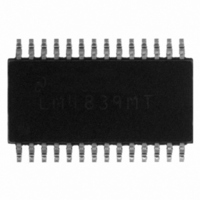LM4839MT/NOPB National Semiconductor, LM4839MT/NOPB Datasheet - Page 17

LM4839MT/NOPB
Manufacturer Part Number
LM4839MT/NOPB
Description
IC AMP AUDIO PWR 2.2W AB 28TSSOP
Manufacturer
National Semiconductor
Series
Boomer®r
Type
Class ABr
Datasheet
1.LM4839LQNOPB.pdf
(34 pages)
Specifications of LM4839MT/NOPB
Output Type
2-Channel (Stereo) with Stereo Headphones
Max Output Power X Channels @ Load
2.2W x 2 @ 3 Ohm; 95mW x 2 @ 32 Ohm
Voltage - Supply
2.7 V ~ 5.5 V
Features
Bass Boost, Depop, Input Multiplexer, Mute, Shutdown, Thermal Protection, Volume Control
Mounting Type
Surface Mount
Package / Case
28-TSSOP
For Use With
LM4839MTBD - BOARD EVALUATION LM4839MT
Lead Free Status / RoHS Status
Lead free / RoHS Compliant
Other names
*LM4839MT
*LM4839MT/NOPB
LM4839MT
*LM4839MT/NOPB
LM4839MT
Application Information
microprocessor, or a microcontroller. When using a switch,
connect an external 10k
SHUTDOWN pin and V
SHUTDOWN pin and ground. Select normal amplifier opera-
tion by closing the switch. Opening the switch connects the
SHUTDOWN pin to V
ing micro-power shutdown. The switch and resistor guaran-
MUTE FUNCTION
The LM4839 mutes the amplifier and DOCK outputs when
V
LM4839 will amplify a system alert (beep) signal whose
magnitude satisfies the BEEP DETECT circuitry. Applying
0V to the MUTE pin returns the LM4839 to normal, unmated
operation. Prevent unanticipated mute behavior by connect-
ing the MUTE pin to V
float.
HP SENSE FUNCTION ( Head Phone In )
Applying a voltage between 4V and V
HP-IN headphone control pin turns off the amps that drive
the left out ’+’ and right out ’+’ pins. ( Pins 15 and 20 on the
MT/MTE & 12 and 25 on the LQ ). This action mutes a
bridged-connected load. Quiescent current consumption is
reduced when the IC is in this single-ended mode.
Figure 2 shows the implementation of the LM4839’s head-
phone control function. With no headphones connected to
the headphone jack, the R1-R2 voltage divider sets the
voltage applied to the HP Sense pin at approximately 50mV.
This 50mV puts the LM4839 into bridged mode operation.
The output coupling capacitor blocks the amplifier’s half
supply DC voltage, protecting the headphones.
The HP-IN threshold is set at 4V. While the LM4839 operates
in bridged mode, the DC potential across the load is essen-
tially 0V. Therefore, even in an ideal situation, the output
swing cannot cause a false single-ended trigger. Connecting
headphones to the headphone jack disconnects the head-
phone jack contact pin from R2 and allows R1 to pull the HP
Sense pin up to V
phone function, turns off both of the ’+’ output amplifiers and
mutes the bridged speaker. The amplifier then drives the
headphones, whose impedance is in parallel with resistors
R2 and R3. These resistors have negligible effect on the
LM4839’s output drive capability since the typical impedance
of headphones is 32 .
Figure 2 also shows the suggested headphone jack electri-
cal connections. The jack is designed to mate with a three-
wire plug. The plug’s tip and ring should each carry one of
the two stereo output signals, whereas the sleeve should
DD
is applied to pin 5, the MUTE pin. Even while muted, the
SHUTDOWN
Logic High
Logic Low
Logic Low
Logic Low
Logic Low
PIN
DD
DD
TABLE 1. Logic Level Truth Table for SHUTDOWN, HP-IN, and MUX Operation
DD
through R4. This enables the head-
DD
through the pull-up resistor, activat-
or ground. Do not let the mute pin
. Connect the switch between the
pull-up resistor between the
DD
HP-IN PIN
Logic High
Logic High
Logic Low
Logic Low
(Continued)
to the LM4839’s
X
17
MUX CHANNEL
tee that the SHUTDOWN pin will not float. This prevents
unwanted state changes. In a system with a microprocessor
or a microcontroller, use a digital output to apply the control
voltage to the SHUTDOWN pin. Driving the SHUTDOWN pin
with active circuitry eliminates the need for a pull up resistor.
carry the ground return. A headphone jack with one control
pin contact is sufficient to drive the HP-IN pin when connect-
ing headphones.
A microprocessor or a switch can replace the headphone
jack contact pin. When a microprocessor or switch applies a
voltage greater than 4V to the HP-IN pin, a bridge-connected
speaker is muted and the single ended output amplifiers A1
and A2 will drive a pair of headphones.
BASS BOOST FUNCTION
The Bass Boost Function can be toggled by changing the
logic at the Bass Boost Select pin. A logic low will switch the
power amplifiers to bass boost mode. In bass boost mode,
the low frequency gain of the ampflifier is set by the external
CBS capacitor in Figure 1. Where as a logic high sets the
amplifiers to unity gain.
In some cases, a designer may want to improve the low
frequency response of the bridged amplifier or incorporate a
bass boost feature. This bass boost can be useful in systems
where speakers are housed in small enclosures. If the de-
signer wishes to dsiable the bass boost feature, pin 19 (
MT/MTE packages ) can be tied to V
SELECT PIN
Logic High
Logic High
Logic Low
Logic Low
FIGURE 2. Headphone Sensing Circuit (MT/MTE
X
(MUX INPUT CHANNEL #)
Single-Ended Amplifiers (1)
Single-Ended Amplifiers (2)
Pinout)
OPERATIONAL MODE
Micro-Power Shutdown
Bridged Amplifiers (1)
Bridged Amplifiers (2)
DD
.
www.national.com
DS200134-4










